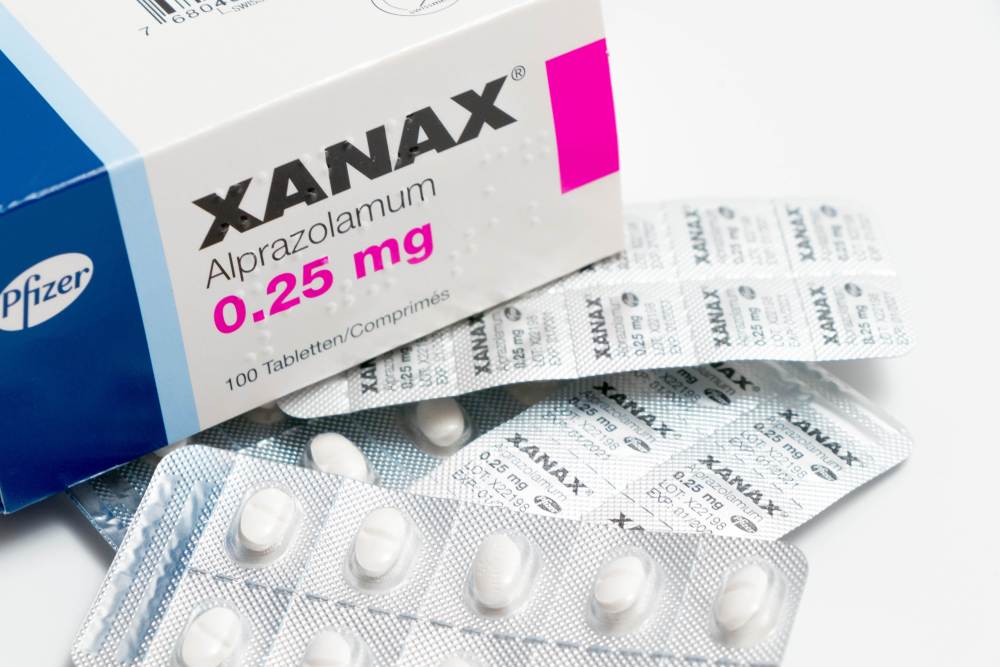Is Xanax an Opioid?
Many people ask: is Xanax an opioid? Many drugs aren’t well understood, particularly when they are used recreationally or when people begin taking a medicine for a specific set of symptoms without learning more about how it is used and why. Xanax is one of those drugs. Opioids are frequently used to treat extreme pain levels, and therefore Xanax is frequently mistaken for them. That can lead to a number of complications over time if you don’t know how to manage your diverse medications. Before we discuss Xanax, it is important to know that Xanax is not an opioid. Instead, Xanax falls under the benzodiazepine classification.
What is Xanax?
Xanax, the generic name for Alprazolam, is a sleep-related disorder and anxiety disorder treatment medication. It is one of the most popular psychiatric medicines. Xanax is used to reduce anxiety and promote relaxation.

What do Xanax Pills Look Like?
Xanax is accessible in a multitude of shapes and colors. Xanax pills are usually white, blue, orange, green, or yellow and either elongated rectangles or triangles. Some of the most popular Xanax pills include White Xanax: scored ovals (.25 mg), Orange Xanax: scored ovals (.5 mg), Blue Xanax: scored ovals (1 mg), and White Xanax Bars: elongated rectangles scored into four sections (2 mg). The word Xanax appears on all these pills. There are, however, many types of generic alprazolam. While generic versions are similar to their branded counterparts, the letters on their pills may differ.
What Does Xanax Feel Like?
When introduced into the bloodstream, Xanax causes a state of euphoria and pleasure instantly. Xanax is regularly used as a recreational drug or without a prescription, and it is said to be calming or sedating. Instead of a “high” produced by cocaine or methamphetamines, Xanax users describe feeling more relaxed, quiet, and tired. A few individuals who take Xanax report memory loss or blackouts, a condition referred to as “xanning out,” and forgetting what transpired for several hours. People who abuse Xanax may experience pleasurable effects such as lightheadedness, a sense of unreality, a feeling of detachment, emotional numbness, and a greater sexual urge.
How do Benzodiazepines Work?
Benzodiazepines are a group of drugs that work as sedatives and anxiolytics. Benzodiazepines are used to manage nervous system hyperactivity, anxiety, fear, tension, and depression. These substances are highly addictive and are classified as Schedule IV controlled substances by the FDA (Food and Drug Administration).
After a person takes a benzodiazepine, it is metabolized by the body and modulates a protein on the surface of brain cells called GABA-A receptors. The GABA receptors on the surface of brain cells normally bind to the most prevalent nervous system neurotransmitter, gamma amino butyric acid (GABA). When bound to the receptor, GABA has a calming effect on both the central nervous system and the brain. The calming effect is heightened and lasts longer in the presence of benzodiazepines than it does if GABA were present alone.
Benzos vs. Opioids
Benzodiazepines are used as sedatives and tranquilizers, reducing awareness to everything around them. During surgeries, their sedative properties make them a popular choice. During panic attacks, their depressive properties help to quell and calm nerves.
In contrast, opioids are analgesics and pain-relievers. Our brain has specialized pain receptors. Opioids bind to them and reduce pain. Opioids consist of both street drugs and prescription-based drugs. For instance, illegal drugs such as Heroin and Opium are available, whereas prescriptions like Oxycodone, Morphine, Fentanyl, Hydrocodone, and so on are available.
These drugs, both opioids and benzodiazepines, are among the most frequently misused prescription medications. Combining them is extremely hazardous.

Is Xanax Addictive?
Yes, Xanax is one of the most addictive benzodiazepine drugs available today, even for those who have been prescribed it for a condition. Xanax is one of the most addictive benzodiazepines on the market today, even for those who have been prescribed it for a condition. Those who chronically abuse Xanax often claim that it is the only way to calm down after a stressful day, reduce anxiety, or get a good night’s sleep. A second reason why someone may become addicted to Xanax is that they take it for fun and then become addicted. Xanax is a party drug most commonly used for its sedative effects.
Long-term use of Xanax can lead to addiction, even if it was initially dispensed for a legitimate purpose. This frequently occurs when people take higher-than-recommended doses or procure Xanax prescriptions from other physicians (doctor shopping). Xanax has been shown to be considerably more lethal than other benzodiazepines used to treat anxiety in some studies.
Signs and Side Effects of Xanax Abuse
An individual who abuses Xanax will likely appear extremely tired. They will most likely appear extremely tired, lacking their usual energy and motivation to engage with friends and family. They may also lose interest in everyday activities.
Signs of Xanax Abuse
Signs of Xanax abuse include:
- Drowsiness
- Poor concentration
- Slurred words
- Poor memory recall
- Nausea
- Headache
- Dry mouth
- Vertigo
- Muscle weakness
- Impaired vision
- Sleeping excessively
- Dizziness
Xanax is often abused with other substances, particularly Opioids and alcohol. When Xanax is taken with other substances, it can lead to serious health problems, including respiratory arrest, coma, and even death. Depending on the substances they take, individuals will display different signs of substance abuse.

Side Effects of Xanax Abuse
Xanax may be deadly when mixed with alcohol or other medications, especially when taken in large amounts. When combined with alcohol, even a small amount of Xanax may cause respiratory failure, severe injury, and coma because of its dual central nervous system depressant effects. If a patient takes a large amount of Xanax, he or she may become extremely sedated for up to several days, which may put them in significant danger if they are sedated in a dangerous environment. Automobile or machinery accidents may result from Xanax sedation, resulting in decreased attentiveness and reaction time.
Long-term Xanax use can cause serious side effects, some of which may be irreversible. Dangerous side effects include:
- Chronic depression
- Aggression
- Delirium
- Cognitive impairment
- Dementia
- Psychosis
Recreational Xanax use differs from Xanax addiction. Individuals commonly abuse Xanax for a specific event, like a party, when they take it recreationally. Xanax is frequently combined with alcohol or other drugs to create the desired buzz. Usually, these people can give up the drug without serious adverse effects. Those who take Xanax recreationally still have some control over their lives and drug use. When a person becomes physically and psychologically dependent on Xanax as a result of chronic use, he or she has developed an addiction. To function properly, an individual with an addiction to Xanax must have it. Drug use is no longer under their control, and this can be seen in nearly all aspects of their life.
Xanax Withdrawal
Withdrawal from Xanax may begin as soon as 24 hours after the last dose and last between a few days to weeks. When used correctly, any benzodiazepine, even Xanax, can lead to dependence and withdrawal when used for as little as 3 to 6 weeks. When used for 6 months or more, around 40% of people experience moderate to severe withdrawal symptoms when they stop taking the drug. Two phases of benzodiazepine withdrawal have been described—acute withdrawal, which occurs between 5 and 28 days after benzodiazepine discontinuation, and a more drawn-out withdrawal phase, which can last up to a year or more in some cases.
It can be extremely difficult to cope with Xanax withdrawal, and sometimes it can be deadly. Within hours of the last Xanax dose, withdrawal symptoms may begin, and they may reach their peak in one to four days. Xanax withdrawal symptoms include:
- Headaches
- Diarrhea
- Muscle pain
- Tremors
- Numbness in extremities
- Light and sound sensitivity
- Appetite loss
- Insomnia
- Anxiety
- Panic attacks
- Paranoia
- Seizures
It’s especially risky to withdraw from Xanax after prolonged use. Due to these risks, medical detox, which is typically provided by a drug rehab facility, is highly recommended by health officials.
Treatment for Xanax Addiction
In order to address the dual nature of addiction to Xanax, clients must be detoxified in order to eliminate both the physical compulsion to take the drug as well as the psychological desire for more of it. Physical withdrawal symptoms can be eased as much as possible with a detox program, while psychological problems might be treated with antianxiety and anticonvulsive drugs.
Xanax addiction can then be subsequently treated with inpatient rehab. These programs offer the highest level of care, support, and structure. Most residential treatment programs last between 28 days and several months. The length of the program will depend on the severity of the addiction and whether there are any co-existing mental health disorders.

For individuals with light Xanax dependencies, outpatient programs that offer medical detox are an alternative to inpatient rehabilitation. These programs may be a better option for those who do not have time or are the sole caretaker for young children. Family therapy, counseling, continuing education, relapse prevention techniques, and support groups are all offered at outpatient facilities. Following a new addiction to Xanax, relapse prevention should be a central component of ongoing rehabilitation. It doesn’t happen overnight—it needs time. Preventing relapse might help you to maintain sobriety until those newly learned habits become part of your lifestyle.
Help for Xanax Addiction in Louisville
Individuals suffering from Xanax addiction or other substance use disorders can receive care, support, and comprehensive treatment at Louisville Recovery. Treatment is critical for a variety of reasons, including providing information about substance abuse, helping people withdraw safely, addressing the root cause of addiction, and helping people build healthier coping, stress management, and relapse prevention skills to maintain abstinence.
If you or a loved one is in need of substance abuse treatment in Louisville or the surrounding area, we can help. Contact Louisville Recovery Center today. We can assist you, and we are prepared to do so.







